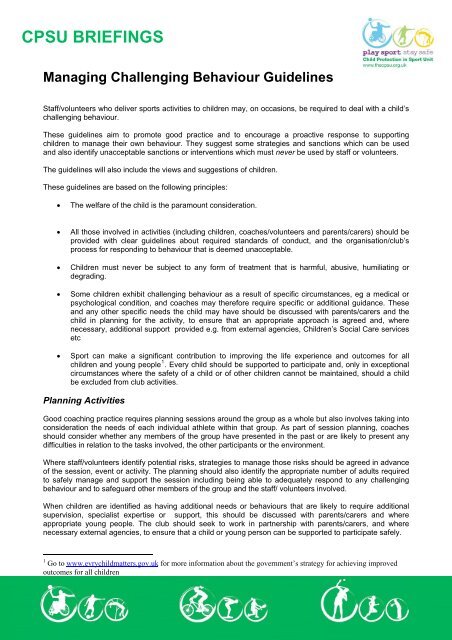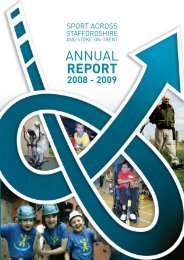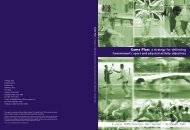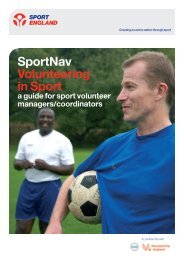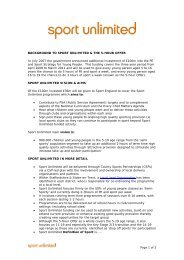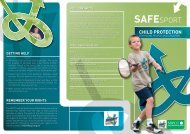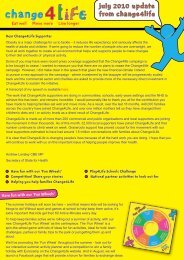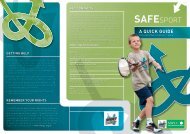Managing challenging behaviour guidelines (Child ... - GreaterSport
Managing challenging behaviour guidelines (Child ... - GreaterSport
Managing challenging behaviour guidelines (Child ... - GreaterSport
Create successful ePaper yourself
Turn your PDF publications into a flip-book with our unique Google optimized e-Paper software.
CPSU BRIEFINGS<br />
<strong>Managing</strong> Challenging Behaviour Guidelines<br />
Staff/volunteers who deliver sports activities to children may, on occasions, be required to deal with a child’s<br />
<strong>challenging</strong> <strong>behaviour</strong>.<br />
These <strong>guidelines</strong> aim to promote good practice and to encourage a proactive response to supporting<br />
children to manage their own <strong>behaviour</strong>. They suggest some strategies and sanctions which can be used<br />
and also identify unacceptable sanctions or interventions which must never be used by staff or volunteers.<br />
The <strong>guidelines</strong> will also include the views and suggestions of children.<br />
These <strong>guidelines</strong> are based on the following principles:<br />
• The welfare of the child is the paramount consideration.<br />
• All those involved in activities (including children, coaches/volunteers and parents/carers) should be<br />
provided with clear <strong>guidelines</strong> about required standards of conduct, and the organisation/club’s<br />
process for responding to <strong>behaviour</strong> that is deemed unacceptable.<br />
• <strong>Child</strong>ren must never be subject to any form of treatment that is harmful, abusive, humiliating or<br />
degrading.<br />
• Some children exhibit <strong>challenging</strong> <strong>behaviour</strong> as a result of specific circumstances, eg a medical or<br />
psychological condition, and coaches may therefore require specific or additional guidance. These<br />
and any other specific needs the child may have should be discussed with parents/carers and the<br />
child in planning for the activity, to ensure that an appropriate approach is agreed and, where<br />
necessary, additional support provided e.g. from external agencies, <strong>Child</strong>ren’s Social Care services<br />
etc<br />
• Sport can make a significant contribution to improving the life experience and outcomes for all<br />
children and young people 1 . Every child should be supported to participate and, only in exceptional<br />
circumstances where the safety of a child or of other children cannot be maintained, should a child<br />
be excluded from club activities.<br />
Planning Activities<br />
Good coaching practice requires planning sessions around the group as a whole but also involves taking into<br />
consideration the needs of each individual athlete within that group. As part of session planning, coaches<br />
should consider whether any members of the group have presented in the past or are likely to present any<br />
difficulties in relation to the tasks involved, the other participants or the environment.<br />
Where staff/volunteers identify potential risks, strategies to manage those risks should be agreed in advance<br />
of the session, event or activity. The planning should also identify the appropriate number of adults required<br />
to safely manage and support the session including being able to adequately respond to any <strong>challenging</strong><br />
<strong>behaviour</strong> and to safeguard other members of the group and the staff/ volunteers involved.<br />
When children are identified as having additional needs or <strong>behaviour</strong>s that are likely to require additional<br />
supervision, specialist expertise or support, this should be discussed with parents/carers and where<br />
appropriate young people. The club should seek to work in partnership with parents/carers, and where<br />
necessary external agencies, to ensure that a child or young person can be supported to participate safely.<br />
1 Go to www.evrychildmatters.gov.uk for more information about the government’s strategy for achieving improved<br />
outcomes for all children
CPSU BRIEFINGS<br />
Agreeing Acceptable and Unacceptable Behaviours<br />
Staff, volunteers, children, young people and parents/carers should be involved in developing an agreed<br />
statement of what constitutes acceptable and unacceptable <strong>behaviour</strong> (code of conduct) and the range of<br />
sanctions which may be applied in response to unacceptable <strong>behaviour</strong>. This can be done at the start of the<br />
season, in advance of a trip away from home or as part of a welcome session at a residential camp.<br />
Issues of <strong>behaviour</strong> and control should regularly be discussed with staff, volunteers, parents and children in<br />
the context of rights and responsibilities. When children are specifically asked, as a group, to draw up a code<br />
of conduct that will govern their participation in club activities, experience indicates that they tend to arrive at<br />
a very sensible and working set of ‘rules’ with greater ‘buy-in’ from participants than those simply imposed by<br />
adults within the club. If and when such a code is compiled, every member of the group can be asked to sign<br />
it, as can new members as they join.<br />
<strong>Managing</strong> Challenging Behaviour<br />
In responding to <strong>challenging</strong> <strong>behaviour</strong> the response should always be proportionate to the actions, be<br />
imposed as soon as is practicable and be fully explained to the child and their parents/carers. In dealing with<br />
children who display negative or <strong>challenging</strong> <strong>behaviour</strong>s, staff and volunteers might consider the following<br />
options:<br />
• Time out - from the activity, group or individual work.<br />
• Reparation - the act or process of making amends.<br />
• Restitution - the act of giving something back.<br />
• Behavioural reinforcement - rewards for good <strong>behaviour</strong>, consequences for negative <strong>behaviour</strong>.<br />
• De-escalation of the situation - talking through with the child.<br />
• Increased supervision by staff/volunteers.<br />
• Use of individual ‘contracts’ or agreements for their future or continued participation.<br />
• Sanctions or consequences e.g. missing an outing.<br />
• Seeking additional/specialist support through working in partnership with other agencies to ensure a<br />
child’s needs are met appropriately e.g. referral for support to <strong>Child</strong>ren’s Social Care, discussion with<br />
the child’s key worker if they have one, speaking to the child’s school about management strategies<br />
(all require parental consent unless the child is felt to be ‘at risk’ or ‘in need of protection’).<br />
• Temporary or permanent exclusion<br />
The following should never be permitted as a means of managing a child’s <strong>behaviour</strong>:<br />
• Physical punishment or the threat of such.<br />
• Refusal to speak to or interact with the child.<br />
• Being deprived of food, water, access to changing facilities or toilets or other essential facilities.<br />
• Verbal intimidation, ridicule or humiliation.<br />
Staff and volunteers should review the needs of any child for whom sanctions are frequently necessary. This<br />
review should involve the child, parents/carers and in some cases others involved in supporting or providing<br />
services for the child and his/her family, to ensure an informed decision is made about the child’s future or<br />
continued participation. As a last resort, if a child continues to present a high level of risk or danger to him or<br />
herself, or others, he or she may have to be suspended or barred from the group or club activities.<br />
Physical Intervention<br />
The use of physical intervention should always be avoided unless it is absolutely necessary to prevent a<br />
child injuring themselves or others, or causing serious damage to property. All forms of physical intervention<br />
should form part of a broader approach to the management of <strong>challenging</strong> <strong>behaviour</strong>.
CPSU BRIEFINGS<br />
Physical contact to prevent something happening should always be the result of conscious<br />
decision-making and not a reaction. Before physically intervening, the member of staff or volunteer should<br />
ask themselves, ‘Is this the only option in order to manage the situation and ensure safety?’ It is good<br />
practice to ensure that if you have to physically intervene in a situation with a child/young person, it is in the<br />
least restrictive way necessary to prevent them from getting hurt, and used only after all other strategies<br />
have been exhausted.. Studies have shown that, where this is the case, children and young people<br />
understand and accept the reasons for the intervention.<br />
The following must always be considered:<br />
• Contact should be avoided with buttocks, genitals and breasts. Staff/volunteers should never behave<br />
in a way which could be interpreted as sexual.<br />
• Any form of physical intervention should achieve an outcome that is in the best interests of the child<br />
whose <strong>behaviour</strong> is of immediate concern.<br />
• Staff/ volunteers should consider the circumstances, the risks associated with employing physical<br />
intervention compared with the risks of not employing physical intervention.<br />
• The scale and nature of physical intervention must always be proportionate to the <strong>behaviour</strong> of the<br />
young person and the nature of harm/ damage they might cause.<br />
• All forms of physical intervention should employ only a reasonable amount of force -ie the minimum<br />
force needed to avert injury to a person or serious damage to property - applied for the shortest<br />
period of time.<br />
• Staff/volunteers should never employ physical interventions which are deemed to present an<br />
unreasonable risk to children or staff/volunteers.<br />
• Staff/volunteers shall never use physical intervention as a form of punishment.<br />
• Physical intervention should NOT involve inflicting pain<br />
• Where children are identified as having additional needs or <strong>behaviour</strong>s that are likely to require<br />
physical intervention this should be discussed with parents/carers and where necessary the club will<br />
seek advice from or to work in partnership with external agencies (e.g. <strong>Child</strong>ren’s Social Care) to<br />
ensure that a child or young person can be supported to participate safely. This may include asking<br />
for the provision of a suitably trained support worker/volunteer or accessing staff/volunteer training in<br />
physical intervention .<br />
Any physical intervention used should be recorded as soon as possible after the incident by the<br />
staff/volunteers involved using the Incident Report Form and passed to the Club Welfare/<strong>Child</strong> Protection<br />
Officer as soon as possible.<br />
Views of the child<br />
It is clear from the accounts of children and young people that physical intervention provokes strong feelings.<br />
<strong>Child</strong>ren may be left physically or emotionally hurt. Even a child who hasn’t directly been involved in the<br />
situation may be fearful that it will happen to them in future or have been upset by seeing what has<br />
happened to others.<br />
A timely debrief for staff/volunteers, the child and parents should always take place following an incident<br />
where physical intervention has been used. This should include ensuring that the physical and emotional<br />
well-being of those involved has been addressed and ongoing support offered where necessary.
CPSU BRIEFINGS<br />
Staff/volunteers, children and parents should be given an opportunity to talk about what<br />
happened in a calm and safe environment.<br />
There should also be a discussion with the child and parents about the child’s needs and continued safe<br />
participation in the group or activity.<br />
It is important that staff and volunteers are made aware of and understand the organisation/club’s guidance<br />
about managing <strong>challenging</strong> <strong>behaviour</strong> to ensure that they are aware of ways in which they may need to<br />
intervene and are clear about the practice guidance in this area.<br />
A policy for managing <strong>challenging</strong> <strong>behaviour</strong><br />
In conclusion, all organisations that have a duty of care to children and young people should develop and<br />
implement a policy and procedures on managing <strong>challenging</strong> <strong>behaviour</strong> or consider incorporating this into<br />
their child protection policy. It should clearly set out the following:<br />
• The standard of conduct expected from staff/volunteers and participants.<br />
• How the organisation will respond to unacceptable <strong>behaviour</strong>s.<br />
• How your organisation will respond to ‘high risk’ <strong>behaviour</strong>s’. This will give children and young<br />
people a clear message about when staff may need to get involved to stop a particular form of<br />
<strong>behaviour</strong>, and describe options to avoid confrontation through for example, time out.<br />
• The circumstances in which children will be restrained. A decision to restrain a child should be<br />
firmly based on the safety of the child and must NEVER be made as a punishment or to get<br />
children to comply with instructions.<br />
• The guidance, information or any support and/or training available to staff/volunteers, particularly<br />
where they are supporting a child with recognised <strong>challenging</strong> <strong>behaviour</strong> to access club<br />
activities.<br />
• The circumstances where external agencies will be contacted for support or in response to<br />
concerns e.g. – <strong>Child</strong>ren’s Social Care services, the Police.<br />
• What will happen after an incident? Your organisation must have in place arrangements to<br />
check on the physical and emotional wellbeing of the child and staff, guidance on recording, who<br />
should be informed and a system for recording and monitoring.<br />
This briefing has been developed from “Creating a Safe Environment in Sport, Scottish Governing Bodies<br />
<strong>Child</strong> Protection Guidelines” (sportscotland/ <strong>Child</strong>ren 1st)<br />
Sign up now to the CPSU E-Newsletter - We can email you the latest information about child protection in sport, simply<br />
e-mail the word subscribe to cpsu@nspcc.org.uk


